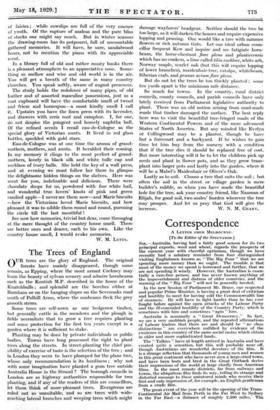The Trees of England
OUR trees are the glory of England. The original forests have mainly disappeared, though some remain, as Epping, where the most arrant Cockney may learn the beauty of sylvan scenery and admire hornbeams such as the Kentish M.P. described in the home of the Knatchbulls ; and splendid are the beeches either at Burnham or on the hanging slopes on the Sevenoaks road south of Polhill Arms, where the sunbeams fleck the grey smooth stems. Some trees are self-sown as our hedgerow timber, but generally cattle in the meadows and the plough in fields necessitate that to grow a tree requires planting and some protection for the first ten years except in a garden where it is sufficient to stake. Planting may be done by private individuals or public bodies. Towns have long possessed the right to plant trees along the streets. In Street-planting the chief pos- sibility of exercise of taste is the selection of the tree; and in London they seem to have plumped for the plane tree, whose only recommendation is its hardiness; why not with some imagination have planted a gum tree outside Australia House in the Strand? The borough councils in London are as highway authorities responsible for tree planting, and if any of the readers of this are councillors, let them think of more 'pleasant trees. Evergreens are ruled out as unsuitable, and so ate trees with wide- reaching lateral branches and weeping trees which might damage wayfarers' headgear. Neither should the tree be too large, as it will darken the houses and require expensive lopping and pruning. One would like a tree with summer flowers or rich autumn tints. Let our ideal urban coun- cillor frequent Kew and inquire and see fatigiate horn- beam, the horse-chestnut flare *no and plantierensis which has no conkers, a lime called tilia euchlore, white ash, Norway maple, scarlet oak (but this will require lopping of lower branches), maidenhair-tree, catalpa, whitebeam, Siberian crab, and prunus avium fiore plena. But do not let the trees be too thickly planted; some ten yards apart is the minimum safe distance. So much for towns. In the country, rural district councils, county councils, and parish councils have only *lately received from Parliament legislative authority to plant. There was an old notion arising from mud-made roads that timber damaged the surface. The best reply here was to visit the beautiful tree-fringed roads of the Western Continental Powers and of the more advanced States of North America. But any minded like Evelyn or Collingwood may be a planter, though he have but a forecourt and a backyard. If he wishes to gain time let him buy from the nursery with a condition that if the tree dies it should- be replaced free of cost. But more interesting will it be to let the children pick up seeds and plant in flower pots, and as they grow trans- plant into larger pots and lastly into the garden, where it will be a Mabel's Maidenhair or Oliver's Oak. Lastly as to soil. Choose a tree that suits the soil; but often the soil in the street or village garden is mere builder's rubble, so when you have made the beautiful hole for the tree, ask your country friend, like Naaman of Elijah, for good soil, two mules' burden wherever the tree may prosper. And let us pray that God will give the












































 Previous page
Previous page